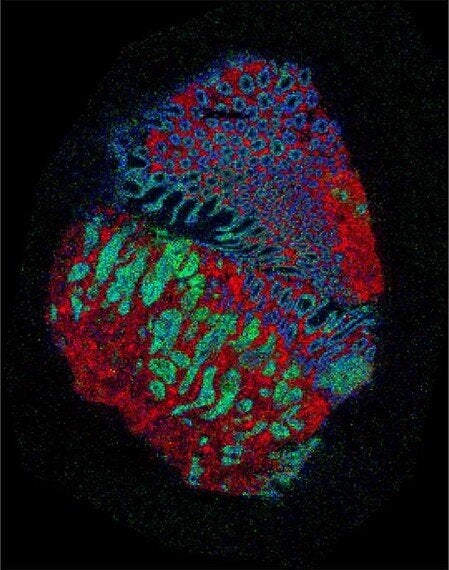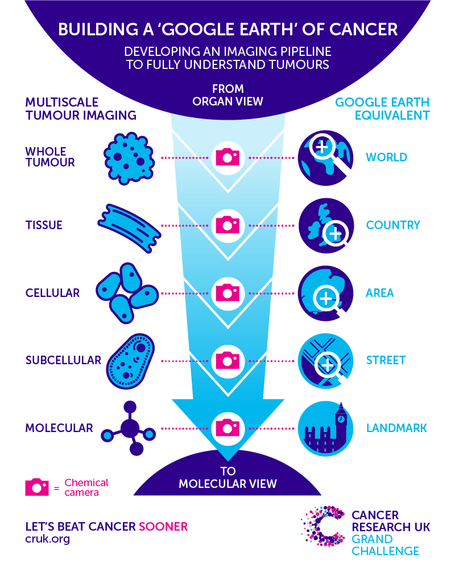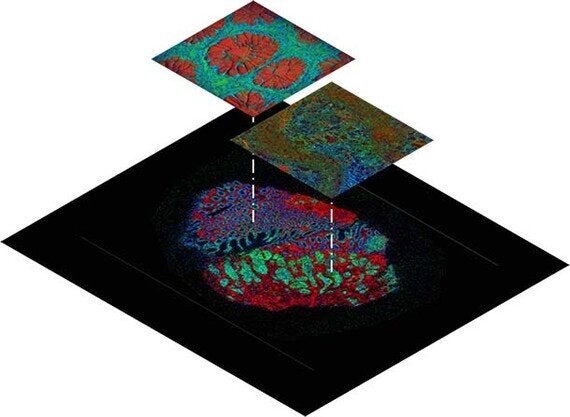Think of a tumour like a rapidly growing city within a patient's body.
Doctors can scan the patient to locate the tumour, much like a satellite can scan the earth and map its cities. And scientists can get a sense of the tumour at 'street level' by looking at its communities of cells through tissue samples and gene-sequencing technology.
But combining all this information for each cell in a tumour to guide diagnosis and treatment can't yet be done.
Our ability to navigate this city, and how it changes, is incomplete. And no single scientific technique can capture all the details of a tumour to recreate zooming in and out of a map on a smartphone, for example.
Without more complete maps of tumours, scientists and doctors are wandering through unknown territory.
"Until we completely understand how tumours are made up it will be very difficult to develop the next wave of treatments for cancer," says Dr Josephine Bunch, from the National Physical Laboratory (NPL) in London.
But Bunch's international team, which received £16 million through Cancer Research UK's Grand Challenge award last month, think they now have the technology to make complete maps of tumours that are so desperately needed.
This is the place to make measurements
Her team will attempt to map every detail of several types of cancer, cataloguing the intact tumour tissue right down to single cells and the molecules held within them. And they'll focus on the processes that fuel how tumours grow (metabolism) with the goal of improving diagnosis and treatment.
It's like stitching together a 'Google Earth' for tumours, she says.
And according to Bunch, there's no better place to be taking on this challenge than NPL, which is the UK's national measurement institute.
Its teams hold the UK kilogram, set time across the country and calibrate all the radiotherapy machines in the NHS.
Making reproducible measurements is what they do, says Bunch. And that will be the focus of their Grand Challenge project as they attempt to create tumour maps that can be reproduced by any scientific or medical team anywhere in the world.
According to Bunch the team was "under no illusion" that what it's proposing would be easy. This is because the team has been tasked with measuring some things that are relatively big (an entire tumour) right down to some things that are very small (individual molecules inside single cells), as quickly as possible. "But we wouldn't have responded if we didn't have huge confidence in our approach," she adds.
When you think of mapping something the most obvious method that springs to mind is taking a picture of it. And in science you might think this means microscopes and scans.
Bunch thinks differently.
"If you look down a microscope then you're most often looking at the structural composition of that tissue," she explains.
Classically this involves using a chemical stain to light up cells and molecules you've chosen to look for. And while that's useful in many ways, Bunch says this falls short in two areas.
First, just looking at the overall structure and shape of a tumour can only tell you so much about the different types of cell the tumour holds, and how they interact. Second, using a chemical stain means "you have to know what you were looking for," because these stains show up "a particular protein and you're looking where that is."
The challenge isn't in measuring what scientists know to look for. "If we knew what to look for we'd have found it already," says Bunch. Instead, they need to measure everything, and hunt through these data for patterns. Bunch's team plan to do this by measuring the chemical and molecular details of tumours in an unbiased way, as comprehensively as possible.
And they're doing this by combining a series of techniques that have never been used together before.
A chemical 'snapshot'
The team's labs at NPL span workshops where they're developing everything from new lasers through to a machine that's the only one in existence in the world.
Each of these specialised instruments is built around a measurement technique known as mass spectrometry, which detects molecules based on their unique mass.
It dates back to the beginning of the 20th century, but in the last few decades a series of new instruments has been developed that uses mass spectrometry data to build a picture of the sample that's being analysed.
"What we do is measure as many molecules as we can at one location," says Bunch. The instrument then moves its focus a fraction further along the sample and makes the same measurement again.
"We do this at hundreds of thousands of locations across the sample so we end up with an enormous amount of data that we can mine in different ways," she adds. From these data we can identify molecules and show where they are in the sample. And this is all without being biased in hunting out a particular type of molecule or cell that the scientist has chosen to look for.

A picture of a bowel cancer sample made using mass spectrometry imaging. The artificial colours represent measurements of molecules and show different types of tissue - red is tissue that lines the bowel, green is the tumour and blue is muscle. Credit: Zoltan Takats, Renata Filipe-Soares (Imperial College London); Nicole Strittmatter, Gregory Hamm, Richard Goodwin (Astra Zeneca); Rory Steven, Adam Taylor, Alan Race, Spencer Thomas, Rasmus Havelund, Josephine Bunch (NPL).
The problem with mass spectrometry, Bunch explains, is that the different ways the instruments work mean that you can only measure certain properties of your sample in each experiment. It's like trying to find a place to eat using a map on your smartphone, but needing to switch to a different device to see each different type of restaurant.
This means that with one machine you might be able to measure something relatively big, a complete piece of tumour tissue for example. But you need another machine to get reliable information about small things in that sample, such as molecules inside single cells in the tissue.
And that's why Bunch's team, which includes many of the inventors of the technology they'll be using, has proposed bringing several instruments together to map tumours in never-before-seen detail.

The techniques range from an advanced surgical knife (called iknife) that can distinguish between healthy and cancerous tissue during surgery, to instruments that can spot individual molecules and drugs inside cells.
And the team is kicking off the project by looking at bowel, breast and pancreatic tumour samples from mice and patients.
Starting with 3 types of cancer
They chose these cancers because they each "present a very different challenge in measurement," says Bunch. That's because each of these types of tissue "are actually very different" so testing their technology against these cancers will make sure it can be applied to as many types of cancer as possible in the future.
By zooming in and out of these tumours the team will be able to pick out key characteristics of these cancers. They'll also be mapping this against how certain drugs work, sharing the data with their pharmaceutical partner AstraZeneca to help speed up how the findings might lead to new treatments.

The team plans to zoom in using different instruments to inspect important areas of the tumour. Credit: Zoltan Takats, Renata Filipe-Soares (Imperial College London); Nicole Strittmatter, Gregory Hamm, Richard Goodwin (Astra Zeneca); Rory Steven, Adam Taylor, Alan Race, Spencer Thomas, Rasmus Havelund, Josephine Bunch (NPL).
They also have their sights set on how these instruments might be used in a clinical setting, both in pathology labs and for monitoring treatment.
"We envisage mass spectrometry imaging being used more fully in a clinical setting," says Bunch. "We hope to show how we can make measurements that will be superior to traditional ways of doing things."
One way they'll do this is with the iKnife, which will gather vital information about these cancers in patients during surgery.
But they plan to take this a step further.
"It would be nice if a patient didn't have to undergo surgery for those measurements to be taken," she says.
So they will be studying their maps to see how they match up with advanced MRI scans through a collaboration with Professor Kevin Brindle from our Cambridge Institute.
By aligning their data with Brindle's, Bunch hopes to develop the least invasive way of understanding the aggressiveness of a tumour and monitoring if treatment is working.
But then comes the challenge of data.
Creating 1 image with 1 technique will produce around 100 gigabytes of data, Bunch estimates.
"We're going to collect hundreds and hundreds of these images using the multiple techniques over 5 years. So a huge challenge of this project is curating, mining and sharing those really precious data."
And the team is already hard at work finding ways to handle this.
Once their database is complete, the next step will be to focus on the measurements and areas of the map that carry the most important information about the tumour.
"The idea is that we might find things that you could then look at in a slightly more targeted manner," says Bunch.
It's these more focused observations that could uncover new targets for drugs, or characteristics of tumours that may lead to new tests or scans.
A measurement that anyone can make
Behind the technical ambition of this project sits Bunch's desire to make sure the team's measurements can be made by others too.
That's the only way this will help improve the outlook for patients, she says.
"It's very important to us that this kind of work, and particularly this investment, delivers methods that are reliable and can be used by other laboratories.
"We will be producing a large searchable database of our 'Google Earth' view of tumours, which will be freely available to researchers around the world.
"We don't want to be the only people who have the knowhow to make these measurements."
Making a difference for patients
There's a long and difficult journey ahead. But Bunch has her heart set on the difference their tumour mapping could make for patients.
"We want to find new ways of diagnosing cancers, we want to develop new treatments and we want to have a major impact on patients' experience from when they are first diagnosed all the way through their treatment."
A big part of making this happen will come through involving patients and the public in the design and assessment of the ongoing research.
Kelly Gleason, a research nurse from Imperial College London, and Harry Hall, who was diagnosed with bowel cancer in 2002, will be guiding the Bunch team along the way.
The team sees the purpose and benefit of involving patients in their research, says Kelly. "They really want to get this part right."
"This is a very exciting time for scientists, but also patients and anyone touched by cancer... it brings such hope," she says.
Kelly and Harry have been a part of the Bunch team from day one. "Josephine and her group have prepared us to be included at every meeting," says Kelly. And Kelly will be welcoming the team to her patient and public involvement group at Imperial to discuss the next steps for involving patients in the project.
"I feel very confident this team will deliver what they have promised," says Kelly. "They are very inclusive and open to learning new things and doing things in different ways while being focused on the task at hand."
This is something that Bunch makes very clear.
"We need drugs to be more effective," she says. And for that to happen "you have to understand the molecular basis of the disease you're treating."
More accurate diagnostics could follow too, with "less invasive measurements and answers faster."
It's not yet clear what the team will uncover. "If we knew what we needed to measure we'd have already done it."
But they're confident that a 'Google Earth' for tumours will help guide the way.
Nick